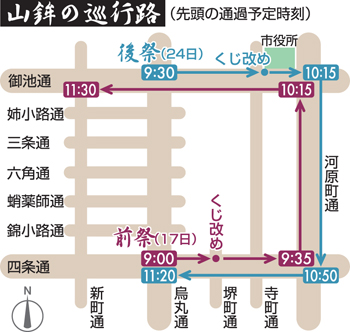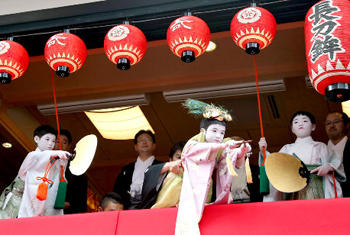
Map showing the direction of the two parades, with the second reversing the processional route of the first. (Kyoto Shinbun)
Turning Point Year for Gion Festival
The Gion Festival, one of Japan’s three major festivals, kicked off on July 1. This year, the “Ato-matsuri,” or the latter festival, is being revived on July 24 for the first time in 49 years, so the “Yamahoko Junko” float procession will parade through central Kyoto City for two days, on both that day and on July 17 for the “Saki-matsuri,” or the former festival. Another hot topic is that the Ofune-hoko float has been revived after 150 years and will hold the last position in the Ato-matsuri Junko procession. This year is a very special in the Gion Festival’s long history.
Formerly, the Yamahoko float procession was divided into two parts, parading on both July 17 for the “Shinko-sai” ritual (Saki-matsuri) and on July 24 for the “Kanko-sai” ritual (Ato-matsuri), as “heralds” for the portable shrines of Yasaka Shrine in Higashiyama Ward, Kyoto. However, after the Second World War, there was a great discussion over which issue was the priority, “Religious faith or tourism.” As a result, it was decided to integrate the Ato-matsuri Junko procession into the Saki-matsuri’s procession for the 48 years from 1966 to 2013, with all Yamahoko floats parading through the city only on July 17.
While this “joint procession” gained a good turnout, the prolonged procession and visitors’ congestion became issues for the festival. As the festival will “return to its original style” this year, the floats will be split with 23 floats in the Saki-matsuri and 10 floats in the Ato-matsuri.
The Ofune-hoko float, which was destroyed in the great fire of the Hamaguri Gomon Incident in 1864, has been reproduced in its original style and will rejoin the festival for the first time in 150 years. It participated in the festival through a “Karabitsu,” a kind of legged, covered chest, in which was placed a divine mask that was saved from the fire, for two years from 2012.
Due to the revival of the Ato-Matsuri Junko procession, there will be traffic restrictions, mainly in Nakagyo and Shimogyo Wards, from July 18 to July 24 as well. (translated by Galileo, Inc)
********************************************
For more detail about the historic changes in 2014, see this posting.

The 'chigo' with a peacock feather headdress performs a dance to initiate the proceedings of the Naginata float on July 5 (for a report, see the Kyoto Shinbun link at the top of the article)

Leave a Reply